Do-it-yourself economical garage heating: how to reduce heat loss and the better it is heated
Many motorists are kind to cars, so they are ready to invest time and energy in the improvement of their garages. Often, the room performs not only its direct functions: it is used as a workshop, pantry and even a place to relax in a male company.
If you equip the economical heating of the garage with your own hands, it will be comfortable to stay in it for many hours. Let's try to figure out how to properly equip the garage heating and what you need to pay attention to in order not to go broke paying bills.
The content of the article:
Advantages and disadvantages of various systems
The garage heating system should be cheap, and this is the main requirement. The owner of the garage has to invest a lot of money in the maintenance and repair of the car, the arrangement of premises for him. This is costly, and it is worth using any opportunity to reduce the cost of heating.
On the other hand, the savings should be reasonable: not at the expense of the efficiency or safety of the system.
There are many different types of systems and devices that can be used to heat the garage. They are not perfect, they have their own shortcomings. Each owner has to decide which selection criteria are most important to him.
Option number 1 - classic water heating
To connect heating to the garage, it is not necessary to install a separate boiler, however, an additional load falls on the general system. This must be taken into account when buying heating appliances and taking them with a power reserve.
Fuel consumption is also increasing, but the cost is still lower compared with the arrangement of a separate heating system for the garage.
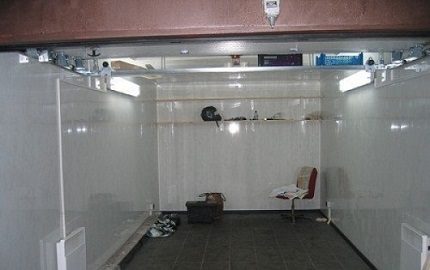
The second option is to equip the garage heating system with a separate boiler. This is a good solution if the building is far from home and the heat loss when moving heated water through pipelines is too large.
When arranging a water system with a separate boiler, it is worth using antifreeze as a coolant to prevent possible defrosting.

The heat carrier is heated in the boiler and piped to the radiators. Cooling down, he again returns to the heater. The system can be single or double pipe. It depends on whether the radiators are connected to the boiler in parallel or in series.
The first type of connection guarantees the same heating of all radiators, however, it requires two pipelines.
For a garage, a one-pipe system is best. Such a scheme allows you to equip heating with minimal material costs, and installation is also simplified. If there are several radiators, they are connected in series.
It is worth considering: in each subsequent device, the coolant temperature decreases.
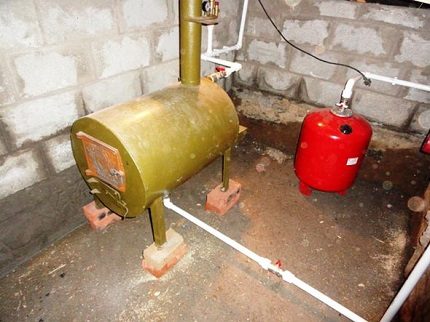
Spacious garages, commercial car repair shops, service stations are equipped with a full-fledged double-circuit heating system. You have to spend money on more materials and complex installation, but the heating of the room will be uniform and efficient.
Option number 2 - heating with gas
Gas heating is the cheapest, however, to connect to the highway you will have to issue a permit from the relevant services. In many cases, garage owners try to avoid a long approval process.
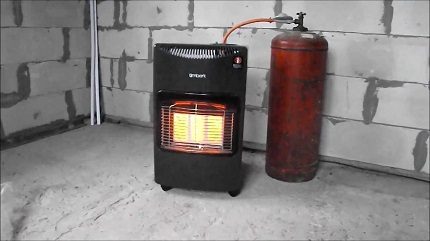
Another caveat: for unauthorized connection to the main pipeline or commissioning, you can pay a serious fine.
Therefore, it is advisable to do everything according to the rules or to use balloon gas mixtures.
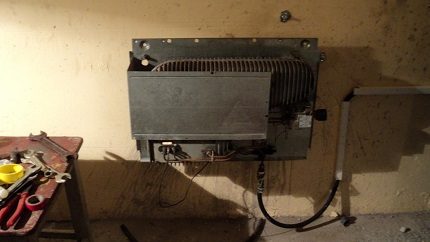
If you connect to the highway, you can provide cheap and highly efficient heating. If you have to use liquefied gas, then you should choose a device that economically consumes fuel. It can be a gas heat gun, infrared heater or convector.
Option number 3 - electric heating
Electrical appliances are considered the safest. They are convenient to operate, compact, efficient and capable of instantly warming the room. Any buyer will find a model of the required power and with the necessary technical parameters.
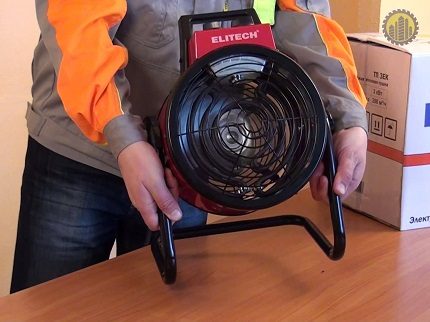
The only drawback of electricity is its high cost, and this immediately crosses out all the advantages. Such electrical appliances should be chosen only for rooms where the owner spends a little time. For permanent garage heating, electric heaters are disadvantageous.
A rational solution is the purchase of a mobile infrared heater, convector, fan heater or heat guns. They are easy to carry, rearrange from place to place. The most powerful and practical devices - heat guns.
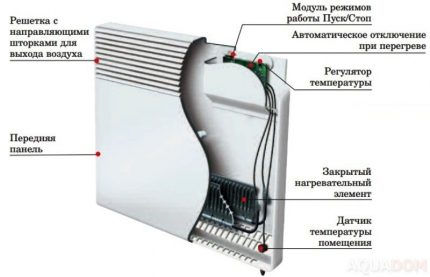
Bad option - oil heater. The device has its advantages, but is more suitable for long-term heating. In addition, it spends a lot of energy, slowly warms up the air.
However, there are exceptions. So, a home-made heater, assembled from an old cast-iron radiator and a heating element, will cost literally a penny. The power of the heating element is chosen by the owner himself, and used oil can be used as a heat carrier.
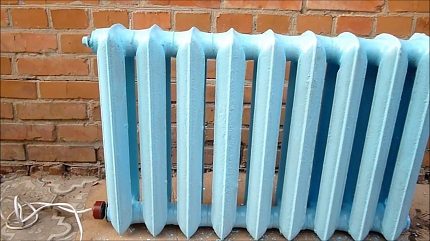
If you add metal legs and attach a dryer to a makeshift heater, you get a convenient multifunctional device. How to do it is described in the master class, which can be found in our selection of video materials.
Option number 4 - solid fuel devices
Boilers, solid fuel stoves are very profitable due to the cheapness of coal and firewood. The disadvantages include the need chimney construction, which leads to some appreciation of the system.
These costs are paid off due to the long service life, efficiency of the stoves, low cost of fuel (you can use waste: sawdust, wood trimmings, any combustible materials).
A solid fuel furnace is cheap, does not require connection to a centralized communication network, and obtaining installation permission. However, it is worth mentioning the disadvantages: increased fire hazard, the need for constant monitoring of combustion, the smell of smoke in the room, the release of harmful substances into the air.
Option No. 5 - liquid fuel furnaces and boilers
Heating appliances operating on diesel fuel, diesel fuel, and mining are popular. They do not have to be bought at the store. It’s quite possible to assemble a liquid fuel boiler with your own hands, garage oven and even a heat gun. Cases of such devices are made of gas cylinders, old barrels, heat-resistant steel sheets.
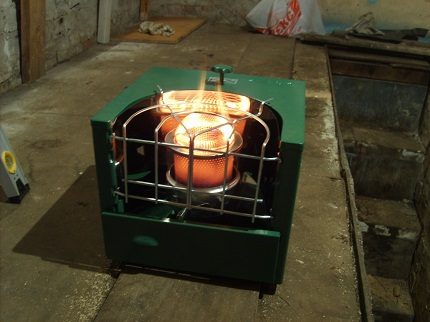
Home-made stoves are not as economical as industrial production models, but they also allow good savings on heating. Fuel consumption of a makeshift miracle furnace or heat gun do-it-yourself is approximately 0.5-0.7 l / h depending on power.
What type of heating is most beneficial?
It all depends on the specific operating conditions and preferences of the garage owner. The cheapest system is a single-tube water system powered by a gas boiler.
It will have to invest considerable funds in its arrangement, but it is so economical that the costs will pay off for 1-2 heating seasons. However, this solution is far from suitable for everyone.
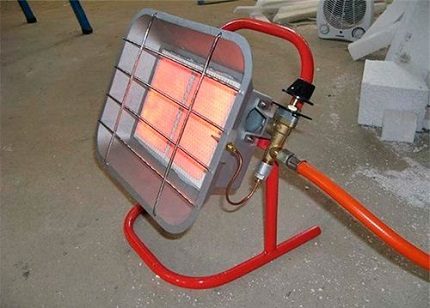
It is possible to economically heat a garage with the help of gas cylinders or solid fuel. These options are not suitable if there is no way to control the operation of the devices, but for heating, while the owner is in the garage, they are good.
How to reduce heat loss and not go broke?
No heating system will be profitable and effective if you do not take care of reducing heat loss. Heaters will be wasting a huge amount of energy. It is expensive and impractical, so you have to insulate the gates, walls, floor and roof.
You can use expanded clay, polystyrene concrete, foil insulation, but the cheapest and most universal option is polystyrene. It is suitable for insulation of all structural elements.
It can also be used for thermal insulation of the floor, provided that a floating screed is made: the foam does not tolerate mechanical stresses, so it is poured with cement.
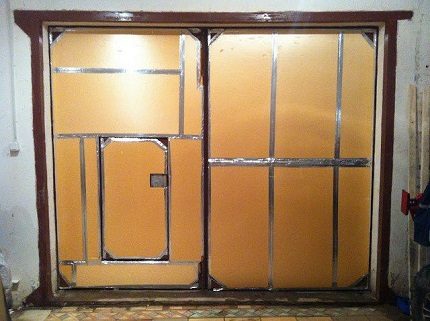
Polyfoam sheathe the ceiling, walls and gates of the garage. Two options are possible - external or external wall decoration. Both are equally effective and can achieve excellent thermal insulation of the building. You should choose based on the convenience of the owner of the garage.
Conclusions and useful video on the topic
We offer a selection of videos that will help you better understand the issues of heating and warming the garage.
Assembly instruction for a super-economical water heating system:
A mini-overview of an economical gas stove that consumes 0.5 l of gas per hour:
Tips for self-assembly of an oil heater from a used cast-iron radiator:
Video instruction on the rational organization of heating in the garage:
Recommendations for reducing heat loss in the garage:
The issue of heating the garage is not difficult to solve. It is enough to deal with the main advantages of each heating system and with possible limitations in its use. You should choose, focusing on your own needs.
The main thing is not to forget about the rules of fire safety. No savings are worth putting your car and your own health at risk.
Perhaps you have personal experience in arranging heating for a garage? Please share your opinion with our readers, tell us which heating system you prefer and why. Leave your comments, ask questions in the block below.

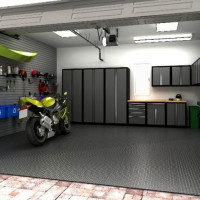 How to better organize garage heating: a comparative overview of the best ways
How to better organize garage heating: a comparative overview of the best ways 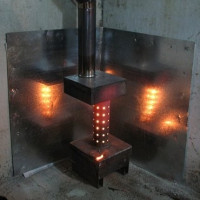 Do-it-yourself garage oven: a step-by-step guide to design
Do-it-yourself garage oven: a step-by-step guide to design 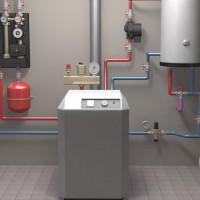 Economical heating of a private house: choosing the most economical heating system
Economical heating of a private house: choosing the most economical heating system 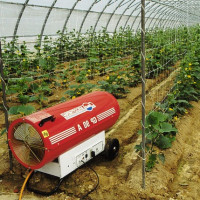 Do-it-yourself greenhouse heating system: the best ways to winter heat greenhouses
Do-it-yourself greenhouse heating system: the best ways to winter heat greenhouses 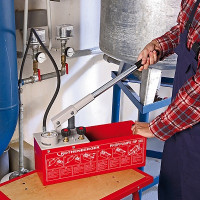 How to pressure test a heating system with your own hands
How to pressure test a heating system with your own hands  How to make a gate for a chimney with your own hands: instructions for making a valve
How to make a gate for a chimney with your own hands: instructions for making a valve  How much does it cost to connect gas to a private house: the price of organizing gas supply
How much does it cost to connect gas to a private house: the price of organizing gas supply  The best washing machines with dryer: model rating and customer tips
The best washing machines with dryer: model rating and customer tips  What is the color temperature of light and the nuances of choosing the temperature of the lamps to suit your needs
What is the color temperature of light and the nuances of choosing the temperature of the lamps to suit your needs  Replacement of a geyser in an apartment: replacement paperwork + basic norms and requirements
Replacement of a geyser in an apartment: replacement paperwork + basic norms and requirements
I love picking cars, so in my new garage I decided to make heating at the same time so that nothing would bother me in winter. I chose how to heat for a long time, but still decided to put water heating. He conducted the pipes from home, so in my opinion the most reliable of all. They did it within 5 days, spent a little more than 25 thousand, but if you yourself do not understand, it is better to turn to knowledgeable people for help.
Still, the usual situation for our country is garage cooperatives in relative remoteness from residential buildings. Therefore, connecting your garage to a common heating system is quite problematic, in my opinion. That remains from the available options - stoves and electric heating. But electricity comes out a little expensive, so most are drowned with wood and coal.
I didn’t understand the joke in the photo. Why did the upper circulation pipes in the buleryan take to the atmosphere, while the air circulation should be inside the garage? What special did this?
From the first time, I also did not understand what was happening and thought in the same way that the upper circulation pipes from the buleryan had been vented into the atmosphere. But everything is not so simple, a comprehensive idea is implemented here, as it turns out.
In this case, heating combined with ventilation is implemented. The heating and ventilation installation itself is not visible in the photo, for an illustrative example I will attach a photo, installation ОВ65.
Today, heating stoves in combination with a duct system in recent years are increasingly used in our country. In the photo, where in the garage buleryan with communications connected to the heating and ventilation installation, most likely, heats up not only the garage, but also other rooms. It is possible that the garage is large, for 3-4 cars, then such an implementation is justified.
For small rooms, this option is best - https://www.youtube.com/watch?v=Qq4zmnxwXns
I have a furnace in my garage, like everyone else :)) and hung a ceramic IR heater. The criterion was the fire safety of the device, as Designed to work precisely in my absence. Consumes 300w. Set the thermostat at 5-7 degrees to save energy. And of course, he insulated everything in the garage. There is also a gas gun - it heats instantly in severe frosts.